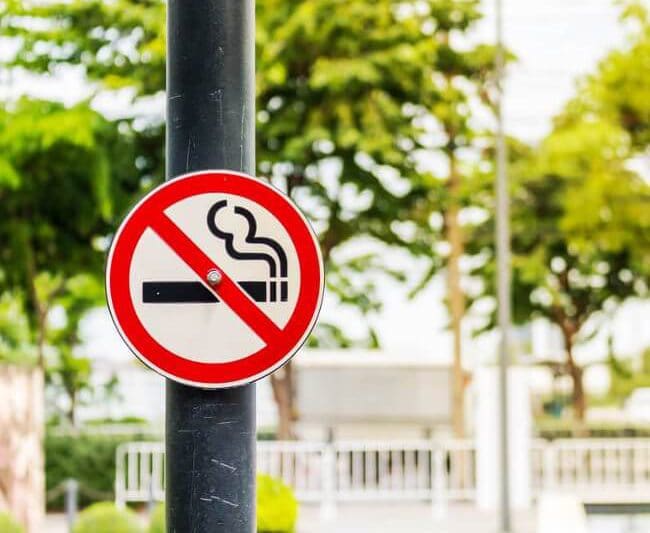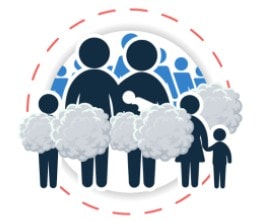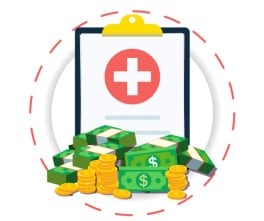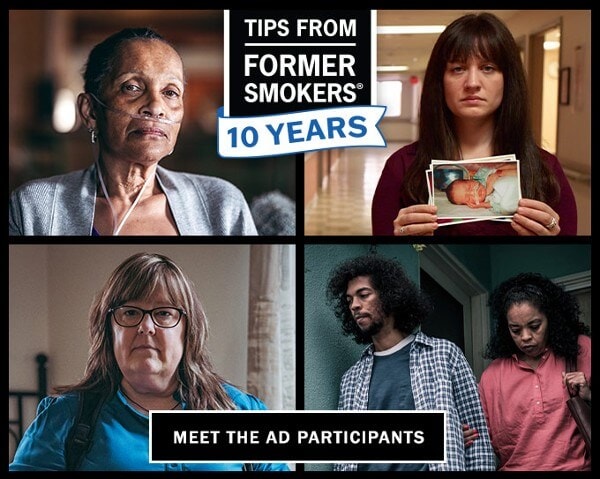Tobacco Use

Commercial* tobacco use is the leading cause of preventable disease, disability, and death in the United States. Every day in the United States, about 1,600 young people under age 18 try their first cigarette, and nearly 200 end up smoking cigarettes daily.
Some groups of people have a higher percentage of tobacco use, secondhand smoke exposure, and related health problems, as well as less access to treatment to help them quit. These disparities can be based on where people live, the kind of job they have, whether they have health insurance, and factors like race, ethnicity, age, or sexual orientation.
Over 16 million people live with at least one disease caused by smoking, and smoking-related illness cost the United States more than $600 billion in 2018. These costs could be reduced if we prevent people from starting to use tobacco and help people who use tobacco quit.
CDC and its partners work to reduce tobacco-related diseases and deaths by:
- Prevent young people from using tobacco products.
- Help people quit using tobacco products.
- Eliminate exposure to secondhand smoke.
- Advance health equity by identifying and eliminating tobacco-related disparities.
* When CDC references tobacco on this web page, we are referring to the use of commercial tobacco and not the sacred and traditional use of tobacco by some American Indian communities.
In the United States:
30.8 MILLION
adults smoke cigarettes.
3.08 MILLION
middle and high school students use tobacco products.

1 IN 4 PEOPLE
who don’t smoke are exposed to secondhand smoke.

Over $240 BILLION
is spent each year to treat smoking-related diseases.
The Harmful Effects of Tobacco Use

Cigarette smoking leads to disease and disability and harms nearly every organ of the body. Smoking causes cancer, heart disease, stroke, lung diseases, type 2 diabetes, and other chronic health conditions. The impact also extends beyond the person who smokes. For example, smoking during pregnancy increases the risk of premature birth (being born too early) and sudden infant death syndrome (SIDS).
Secondhand smoke, which affects 58 million Americans who don’t smoke, also causes stroke, lung cancer, and heart disease in adults. Children who are exposed to secondhand smoke are at increased risk of SIDS, impaired lung function, acute respiratory infections, middle ear disease, and more frequent and severe asthma attacks.
Cancer
Cigarette smoking causes several forms of cancer, including about 80% to 90% of lung cancer deaths. People who don’t smoke can also develop lung cancer, and those who are exposed to secondhand smoke at home or work have a 20% to 30% higher risk of getting lung cancer than those not exposed. Smoking also causes cancers of the voice box (larynx), mouth and throat, esophagus, bladder, kidney, liver, pancreas, cervix, colon, rectum, and stomach, as well as a type of blood cancer called acute myeloid leukemia. It can also interfere with cancer treatment, increasing the risk of recurrence, more serious complications, and death.
Heart Disease and Stroke
Cigarette smoking is a major cause of heart disease and stroke and causes 1 in every 4 deaths from heart disease and stroke. People who don’t smoke but breathe secondhand smoke at home or work have a 25% to 30% higher risk of heart disease and a 20% to 30% higher risk of stroke. Smoking can damage the body by:
- Raising triglycerides (a type of fat in the blood) and lowering high-density lipoprotein (HDL) or “good” cholesterol.
- Making blood sticky and more likely to clot, which can block blood flow to the heart and brain.
- Damaging cells that line blood vessels, increasing the buildup of plaque (fat, cholesterol, calcium, and other substances) in blood vessels, and causing blood vessels to thicken and narrow.
Lung Disease
Cigarette smoking can cause lung disease by damaging the airways and the small air sacs (alveoli) found in the lungs. It can cause chronic obstructive pulmonary disease (COPD), which includes emphysema and chronic bronchitis. Smoking accounts for as many as 8 in 10 COPD-related deaths. If you have asthma, tobacco smoke can trigger an asthma attack or make an attack worse.
Diabetes
The risk of developing type 2 diabetes is 30% to 40% higher for current smokers than nonsmokers. The more cigarettes a person smokes, the higher their risk of type 2 diabetes. People with diabetes who smoke are more likely than nonsmokers to have trouble managing their blood sugar and to have serious complications, including:
- Heart disease and kidney disease.
- Poor blood flow in the legs and feet that can lead to infections, ulcers, and amputation (surgery to remove a body part, such as toes or feet).
- Retinopathy (an eye disease that can cause blindness).
- Peripheral neuropathy (nerve damage in the hands, arms, feet, and legs that causes numbness, pain, weakness, and poor coordination).
Pregnancy Complications
Cigarette smoking during pregnancy increases the risk of pregnancy complications, including premature birth, low birth weight, certain birth defects, and SIDS. Smoking can also make it harder for a woman to get pregnant. In addition, exposure to secondhand smoke is dangerous for infants and increases the risk of SIDS, slowed lung growth, and middle ear disease.
CDC’s Response to Tobacco Use
Measure Tobacco Use and Translate Data Into Effective Action

CDC collects, studies, and shares information to assess tobacco use and its effects on health, promote evidence-based approaches, and measure progress toward goals. CDC uses this information to:
- Monitor changes and trends in the use of tobacco products among young people and adults.
- Understand tobacco-related knowledge, attitudes, and behaviors among young people and adults.
- Promote the impact of comprehensive tobacco control programs and policies.
- Answer important questions about tobacco use and tobacco control.
- Measure how tobacco use affects population groups to reduce health disparities and advance health equity.
Information is shared in high-quality reports, easy-to-understand web resources, infographics, and interactive data applications. The Tobacco Use Data Portal provides access to the latest tobacco prevention and control data, graphs, and maps, which users can download for more analysis. The STATE System provides data on state tobacco use prevention and control policies.
Support Comprehensive Tobacco Control Programs
In FY 2021, CDC provided over $96 million to 50 states and the District of Columbia, 8 US territories and freely associated states, 26 tribes/tribal organizations, 8 national networks, and several other partners to support their work in reducing tobacco-related disease and death. Recipients focus on using evidence-based strategies to achieve the following OSH goals:
- Prevent young people from using tobacco products.
- Help people quit using tobacco products.
- Eliminate exposure to secondhand smoke.
- Advance health equity by identifying and eliminating tobacco-related disparities.
States that have made larger investments in comprehensive tobacco control programs have seen larger and faster declines in cigarette smoking among adults and young people. For every $1 spent on comprehensive tobacco control programs, states get a $55 return on investment, mostly in averted health care costs to treat smoking-related illness.
Help All People Understand the Dangers of Smoking

Now in its 10th year, the Tips From Former Smokers® (Tips®) campaign has helped more than 1 million US adults quit smoking and millions more try to quit.
CDC’s Tips From Former Smokers® (Tips®) campaign, the first federally funded national tobacco education campaign, focuses on motivating US adults who smoke to try to quit. Tips features real people who are living with serious health conditions caused by smoking and breathing secondhand smoke. For every American who dies because of smoking, at least 30 are living with a serious smoking-related illness. Hard-hitting media campaigns are a proven way to raise awareness about the dangers of smoking and to motivate people to quit.
Tips connects people who smoke with resources to help them quit, including 1-800-QUIT-NOW, which directs people to free services from their state quitlines. With CDC support, state quitlines are able to handle the increases in calls they receive during the Tips campaign.
Help All People Quit Using Tobacco
CDC helps people quit using tobacco by promoting free support services such as:
- CDC.gov/quit, which has information about how to quit smoking and resources that provide quitting support.
- 1-800-QUIT-NOW, a toll-free telephone portal that routes callers to their state quitlines. Callers have access to a variety of quitting services available in multiple languages.
- The national texting portal (text QUITNOW to 333888), which connects people to text messaging services and other state resources in English and Spanish.
State tobacco control programs can access cessation-related materials, including information about best practices, clinical guidelines, and health insurance coverage.
CDC also works with health insurers, health care providers, and employers to improve support for people who want to quit using tobacco. CDC’s activities include:
- Promoting coverage of proven tobacco cessation treatments and the removal of barriers to these treatments.
- Promoting health system changes that ensure that providers ask patients if they use tobacco, advise them to quit, and help them quit by providing cessation counseling and medicines.
- Encouraging employers to cover proven tobacco cessation treatments for workers and their families and to have tobacco-free workplace policies.
- Educating people who smoke on the benefits of using proven tobacco cessation treatments when trying to quit.
Help All People Understand the Risks of Youth Tobacco Use
Despite the good news that cigarette smoking is decreasing among young people, over 2.5 million middle and high school students used electronic cigarettes (e-cigarettes) in 2022. This is a concern because any tobacco use among young people—whether smoked, smokeless, or electronic—is unsafe. Nicotine is addictive and can harm the developing brain.
In addition to monitoring tobacco use among young people, CDC helps parents, educators, health care providers, and other youth influencers understand and talk to young people about the dangers of tobacco products. CDC’s activities include:
- Developing easy-to-understand materials using the best available science.
- Using digital and social media platforms to create and deliver information where young people and youth influencers seek information.
- Working with all 50 states and the District of Columbia to support state and community activities to prevent use of emerging tobacco products, including e-cigarettes, among youth and young adults.